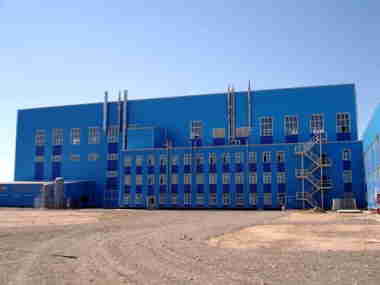Uranium One is planning "significant" reductions in exploration expenditure across all its operations after a third quarter which saw net losses of $2 billion from continuing operations.
 |
| South Inkai in-situ recovery plant is in pre-commercial operation (Image: Uranium One) |
Uranium One president and CEO Jean Nortier said that the company would be focusing on its low-cost Kazakh projects while continuing to develop what he described as key projects in other jurisdictions. "Our cash resources on hand are sufficient to develop our priority projects," he said. Uranium One owns or has interests in projects in Kazakhstan, South Africa, Australia and the USA. Of those, only the Akdala mine in Kazakhstan, in which it has a 70% interest, is operating commercially. The South Inkai project, also in Kazakhstan, is in pre-commercial production.
Uranium One's production for the quarter was 704,600 pounds U3O8, 8% down on the previous quarter. The company now estimates its total attributable production for 2009 will be 3.5 million pounds U3O8, all from the Kazakh interests: 1.8 billion pounds from Akdala, 1.5 million pounds from South Inkai and 0.2 million pounds from Kharasan, where pilot operations began in September 2008. For 2010, it estimates that figure to be 5.6 million pounds U3O8, including initial production from the Moore Ranch project in Wyoming, expected to start during the second half of 2010. Site development work at Honeymoon is likely to recommence in 2009, assuming the partnership agreement with Mitsui is finalized as planned on 1 January, with production slated for 2010.
Uranium One recently suspended operations at its 100%-owned Dominion uranium project in South Africa and put the mine on care-and-maintenance pending a possible sale or permanent closure, depending on the economic situation. Pre-commercial production at the mine, which when fully commissioned should have produced over 4 million pounds U3O8 per year, was 75,800 pounds U3O8 for the quarter up to the closure decision on 22 October. Care and maintenance of the site will cost the company about $12 million per year after the initial cost of suspending operations, estimated at $32 million.
The company says it has written down mineral interests, plant and equipment by $2.8 billion in the third quarter of 2008, made up of $1.8 billion on Dominion, $0.7 billion on its exploration properties in the USA, $0.2 billion on its Australian interests (the Honeymoon project and exploration), and $0.1 billion on its other US projects (Hobson, La Palanga and the Shootaring Canyon mill).
Acid shortages continue
All Kazakhstan's uranium producers have been affected by problems with supplies of sulphuric acid, a vital feedstock for the in-situ leach process. Although the new 1.2 million tonnes per year Kazakhmys Balkhash sulphuric acid plant started up in June, a lack of available railcars has led to problems with distribution in the short term. Uranium One says its Kazakh projects are likely to face sulphuric acid supply problems for the rest of 2008 and the first half of 2009.
In the longer term, the company is involved in a joint venture with Kazatomprom and other affected parties to build a new sulphuric acid plant at Zhanakorgan, near Kharasan. Engineering and procurement contracts have been signed for the project, and the $209 million plant is expected to be completed in 2011.





_18570.jpg)
_16159.jpg)
_49205.jpg)





